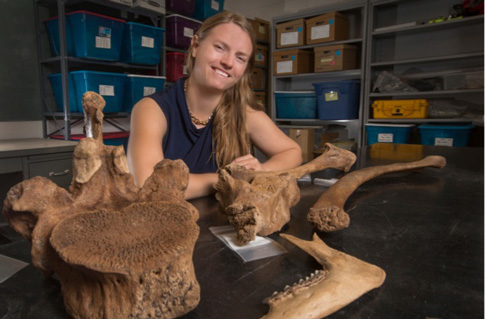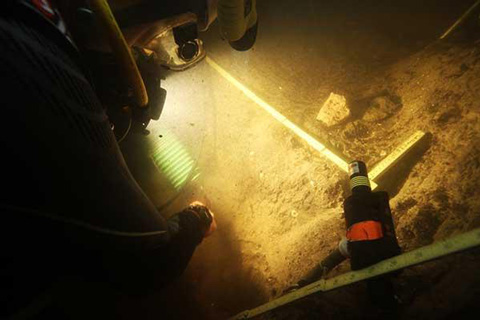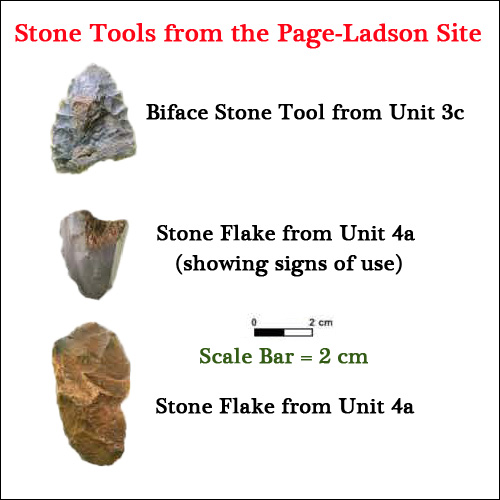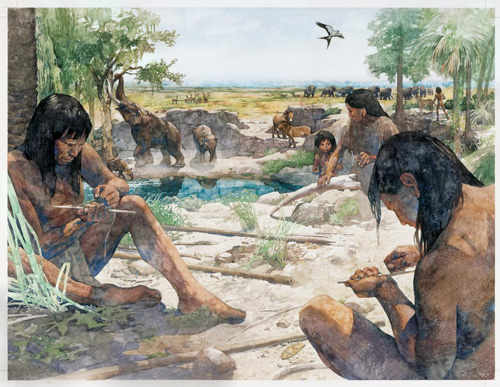The Oldest Floridians
The discovery of ancient mammal remains plus stone tools in association with them is helping a team of scientists to redraw the map of human settlement in the Americas. Evidence suggests that the north-western part of Florida (United States), was inhabited by humans some 1,500 years earlier than previously thought. The research paper detailing the discoveries and the dating information has just been published in the open access journal “Science Advances”.
Stone Tools and Fossil Bones
Lead author of the scientific paper, Assistant Professor of Anthropology at Florida State University Jessi Halligan, had to employ her skills as a diver to reach the site, as the evidence of pre-Clovis existence has come from a sinkhole in the middle of the Aucilla River some ten metres below the water surface. Radiocarbon dating of the artefacts excavated suggests that humans inhabited this part of Florida some 14,550 years ago.
Assistant Professor Halligan with Some of the Fossil Bones

Scientists state that humans occupied the south-eastern United States 1,500 years earlier than previously thought.
Picture credit: Bruce Palmer/Florida State University
The picture about shows Jessi Halligan and some of the prehistoric mammal bones recovered from the site. In the foreground (left) is a vertebra from a Mastodon, in the foreground (right) is the lower jaw (dentary) of a prehistoric Llama.
Prior to this research, it had been widely believed that the first people to live in this part of the Americas were the Clovis people which reached this part of the continent some 13,000 years ago. The Clovis people are believed to have migrated across the Bering land bridge from Asia as the Last Ice Age ended, they moved through Canada and into the northern parts of the United States and over many generations gradually moved further and further south.
The Clovis Culture
The Clovis culture is believed to represent the first widespread human culture in the New World and it is likely that the Clovis people were the ancestors of the native American Indians. It is from the Clovis culture that the various native American cultures evolved. Named from the distinctive stone tools such as finely crafted spear points found at Clovis in New Mexico, many Clovis sites have been excavated and DNA evidence suggests that more than three-quarters of all living native Americans in North and South America are directly related to the Clovis people.
Human Migration Through the Americas is a Complex Picture
As the last Ice Age ended and the ice sheets retreated, so humans migrated across the Bering Strait land bridge (Beringia) and into the New World. However, mapping the extent of this colonisation and the journey south has proved extremely difficult, with a range of dates given for different sites. There has been evidence presented before that suggested humans lived in parts of the Americas earlier than 10,000 to 12,000 years ago, but the evidence had been controversial.
However, at the Aucilla River site, some seventy-one items have been radiocarbon dated and they all support the idea that the stone tools and bones, many of which show cut marks made from tools , indicate human habitation as early as 14,550 years ago.
Commenting on the significance of this research, Assistant Professor Halligan stated:
“This is a big deal! There were people here. So how did they live? This has opened up a whole new line of inquiry for us as scientists as we try to understand the settlement of the Americas.”
The Remarkable Page-Ladson Site
The excavations took place at a site on a bend in the Aucilla River some twenty miles east of the Florida State capital Tallahassee. Animal bones had been found in this region for many years but it was first explored and mapped extensively by diver Buddy Page who found Mastodon remains and brought the site to the attention of archaeologists and palaeontologists. The site is owned by the Ladson family and as result the sinkhole and subsequent cores that have been taken from the river bed are collectively referred to as the Page-Ladson prehistory site.
The location represents a water hole that was filled in by deposits and these deposits represent Late Pleistocene material at the bottom, leading up through to younger Early Holocene deposits that are exposed on the river bed.
Working up to Ten Metres Underwater to Find Traces of Human Activity
Picture credit: Florida State University
Stone Tools and Fossil Animal Bones Preserve Evidence of Human Activity
There are a cluster of sites dotted all over North America that date to around 13,200 years ago, but there are estimated to be only about five in all of the New World that are believed to provide older evidence of human habitation.
Assistant Professor Halligan worked in collaboration with Michael Waters from Texas A&M University and Daniel Fisher (University of Michigan) to excavate the site. The research team were aware that a number of fossil bones and other finds had already been excavated from the site, but between 2012 and 2014 the Page-Ladson prehistory site was once again opened up and explored.
One of the team’s most significant finds was a biface, a stone tool flaked on both sides to produce a knife-like instrument with two cutting edges. Daniel Fisher (vertebrate palaeontologist), also took a close look at the Mastodon tusk that had been retrieved in the 1980s and he was able to identify cut marks indicating that the tusk had been removed by people. The scientists are not certain whether the Mastodon was killed by humans or its carcase was scavenged.
Michael Waters ( Texas A&M’s Centre for the Study of the First Americans) explained:
“The new discoveries at Page-Ladson show that people were living in the Gulf Coast area much earlier than believed.”
Examples of Stone Tools Recovered from the Page-Ladson Prehistory Site
Picture credit: Science Advances with notation by Everything Dinosaur
The picture above show examples of the stone tools recovered from the Page-Ladson location. The biface stone tool “top” has two flaked cutting blades and would have performed the role of a small knife, similar to the type of tool that created the butchery marks in the animal bones. The stone tools (middle and bottom) are typical flakes, the middle flake shows signs of wear (use).
Pleistocene Marine Transgression
Florida in the latter stages of the Pleistocene Epoch was much drier than it is today. Sea levels were over one hundred metres lower. The Page-Ladson site represents a spring fed waterhole that existed in a ravine. It may have been the only reliable water source for miles around and as such, it attracted animals and people to it. With the rise in global temperatures, the great ice sheets that covered much of the Northern Hemisphere began to melt. This led to a rise in global sea levels resulting in low-lying areas becoming flooded (the Late Pleistocene marine transgression). The Page-Ladson site was buried with an influx of sediment and left submerged.
This location in north-western Florida is helping anthropologists to understand more about the migration of humans into the New World and also provides further information with regards to the megafauna that shared this Late Pleistocene habitat.
An Illustration of the Page-Ladson Prehistory Site
Picture credit: Greg Harlin
For replicas and figures of early hominins and prehistoric mammals: Safari Ltd. Wild Safari Prehistoric World Models.









Leave A Comment